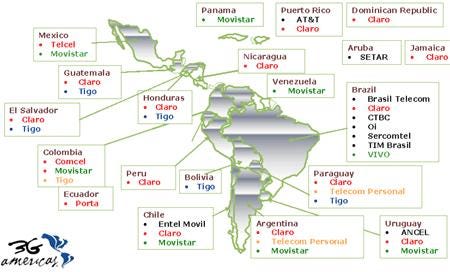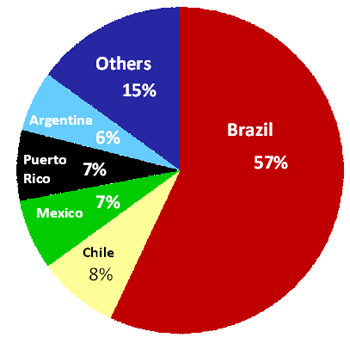Top regional markets in 2008 Telecom revenues Service penetrations Operator trends
February 25, 2009

Latin America, although home to the "B" in the BRIC (Brazil, Russia, India, and China) quartet of leading emerging economies, is still relatively small as a regional telecom service market, accounting for only about 10 percent of total global revenues. But a combination of large geographical size and population, economic resources and growth, and growing telecom liberalization and investment are moving the market forward.
Big international carriers certainly see the region’s potential and are building up their infrastructures and capabilities there. During 2008, Global Crossing (Nasdaq: GLBC), for example:
Added three high-capacity Supercore routers in Buenos Aires, Argentina; Santiago, Chile; and São Paulo, Brazil – thereby tripling POP-to-POP core capacity on its regional MPLS-network backbone and enabling OC192 Sonet connections on the company's South American Crossing (SAC) undersea fiber optic cable system, which rings Latin America. This is to meet growing demand for bandwidth-intensive applications and converged Internet Protocol (IP) services in Latin America. (See Global Crossing Extends Net.)
Lit its new fiber-optic submarine cable in Esterillos, Parrita, Puntarenas, in Costa Rica, which will increase and improve that country’s international connectivity. (See Global Crossing Lights Underseas Cable.)
Expanded its enterprise managed network services from Columbia to Brazil; a further expansion to Argentina is planned. (See Global Xing Expands in LatAm.)
Became a SAP-certified hosting partner in Colombia and Brazil, as well as in Argentina and Chile, thereby allowing it to manage, host, and implement SAP applications for enterprises in “strategic markets” in Latin America. (See Global Crossing Certified.)
Meanwhile BT Group plc (NYSE: BT; London: BTA) reported in July 2008 that its Latin American organization had “successfully completed its first year after the completion of the acquisition of Comsat International and has achieved the goal of reinforcing BT’s global capabilities to better serve its customers in the region.” As a result of the June 2007 acquisition, BT has a 180-POP pan-regional network covering Latin America, supplemented by VSATs for resilience, backup, and serving remote areas, and has data centers in Argentina, Brazil, and Colombia.
And Spain’s Telefónica SA (NYSE: TEF), which claims the largest telecom network in Latin America, announced that it had been selected by Microsoft to provide VOIP services (as Voype) to Windows Live Messenger customers in Argentina, Brazil, Chile, Colombia, Peru, Venezuela, and the United States. Telefónica and the other big player, América Móvil S.A. de C.V. , between them control about 70 to 80 percent of the telecom market.
This report therefore aims to capture aspects of this operator activity and growth potential through some selected data tables, together with some topical information and comment on aspects of the region’s telecom market evolution to provide a snapshot of progress. It provides a ranking of the region’s separate markets by various key parameters, and also focuses on some key growth opportunities.
The data is supplied by Pyramid Research , a market research and advisory service company that's now part of the Light Reading Communications Network. Pyramid analyzes and forecasts demand for communications and media services, applications, networks, and devices in more than 100 countries, with a strong focus on developing markets.
Future editions of the report will update, replace, or extend the data tables as appropriate.
Here’s a hyperlinked contents list:
Page 2: Markets, Services & Definitions
Page 3: The Top 10
— Tim Hills is a freelance telecommunications writer and journalist. He's a regular author of Light Reading reports.
Next Page: Markets, Services & Definitions
This report is limited to the following Latin American markets:
Argentina
Bolivia
Brazil
Chile
Colombia
Costa Rica
Dominican Republic
Ecuador
El Salvador
Guatemala
Honduras
Mexico
Nicaragua
Panama
Paraguay
Peru
Puerto Rico
Uruguay
Venezuela
Services
The Tables are limited to the following telecom services:
Fixed Voice (includes both PSTN and VOIP)
Fixed Internet
Fixed IPTV/Video
Mobile Voice
Mobile Data
They include both business and residential customers. Services supplied exclusively to businesses, such as leased lines, are excluded.
Subscribers and Service Per-Population Penetrations
Penetration (calculated in various ways) is a measure of adoption of a telecommunications service in a country, and is generally used as a comparative measure of network development with other countries or to compare the different adoption rates of similar service offerings. The Per-Population penetrations in this report are calculated by dividing the total number of subscribers (or users in one case), both business and residential, by the mid-year population of the country concerned.
This report looks at the per-population penetrations for:
Narrowband Subscriber Lines: Defined as a subscriber line with a transmission speed less than or equal to 128 kbit/s. Includes plain old telephone service (POTS) or publicly switched telephone network (PSTN), basic rate interface (BRI) ISDN connections, and low-speed fixed wireless connections.
Broadband Subscriber Lines: Defined as a subscriber line with a transmission speed greater than 128 kbit/s. Includes primary rate interface (PRI) ISDN connections, xDSL connections, cable modems, fiber connections, high-speed fixed wireless connections, and other broadband access technologies such as satellite and power line.
Mobile Subscribers: Number of registered mobile accounts (prepaid or postpaid) as a percentage of the population.
Currently, absolute numbers of IPTV/Video Subscriber Lines in the region are generally so low that sensible per-population penetrations cannot be given.
Revenues
All revenues are retail and exclude VAT. Revenues are calculated on a bottom-up basis from their various components, as follows:
Total Fixed + Mobile Revenues is the sum of Total Fixed and Total Mobile Revenues.
Total Fixed Revenues is the sum of Voice Service, Internet Service, and Video/IPTV Revenues.
Total Mobile Revenues is the sum of Mobile Voice and Data Revenues.
Data Sources
All data in the Tables are sourced from Pyramid Research , which operates an ongoing and phased program of country research and data collection. Figures for 2008 are estimates released as part of Pyramid’s 4Q2008 Forecast Release in December 2008. Revenues are given in U.S. dollars, converted at the average exchange rate for the year concerned.
Next Page: The Top 10
This report ranks the top 10 Latin American markets by service revenues and per-population service penetrations.
The Big Spenders
Table 1 ranks the Top 10 Latin American markets by spending on the following categories of telecom services:
Total Fixed = Total Fixed Voice + Total Fixed Internet + Total Fixed IPTV/Video
Total Mobile = Total Mobile Voice + Total Mobile Data
Total Fixed and Mobile
Table 1: Top 10 by Service Revenues, 2008
Market | Total Fixed + Mobile Revenues, $M | Market | Total Fixed Revenues, $M | Market | Total Mobile Revenues, $M |
Brazil | 55,422 | Brazil | 29,877 | Brazil | 25,545 |
Mexico | 27,708 | Mexico | 11,814 | Mexico | 15,894 |
Argentina | 8,816 | Colombia | 3,112 | Argentina | 6,136 |
Venezuela | 7,354 | Argentina | 2,680 | Venezuela | 5,080 |
Colombia | 7,061 | Venezuela | 2,273 | Colombia | 3,950 |
Chile | 4,875 | Peru | 1,637 | Chile | 3,244 |
Peru | 3,427 | Chile | 1,630 | Peru | 1,790 |
Puerto Rico | 2,588 | Dominican Republic | 997 | Puerto Rico | 1,748 |
Guatemala | 2,263 | Puerto Rico | 840 | Guatemala | 1,543 |
Dominican Republic | 1,987 | Guatemala | 720 | Ecuador | 1,229 |
Source: Pyramid Research / Light Reading, 2009 |
Generally, the rankings follow that of nominal GDP (see Table 2), which means that the highly skewed economic distribution of the region puts the two giants of Brazil and Mexico well to the fore.
Table 2 also shows these two markets as having much greater populations than the others, which will tend to inflate absolute numbers, especially for mobile revenues. However, in terns of per-population telecom revenues, it is the smaller markets of Puerto Rico, Uruguay, and Chile that rise to the top of the ranking, pushing Brazil and Mexico down into fourth and sixth places, respectively.
Table 2: Top 10 by GDP, Population & Total Fixed + Mobile Revenues as Percentage of GDP, 2008
Market | Nominal GDP, $M | Market | Population, 000 | Market | Total Fixed + Mobile as % Nominal GDP | Market | Total Fixed + Mobile Revenues per-population, $ |
Brazil | 1,518,218 | Brazil | 191,870 | Nicaragua | 7.7% | Puerto Rico | 653 |
Mexico | 1,040,482 | Mexico | 106,919 | Honduras | 6.4% | Uruguay | 424 |
Venezuela | 337,974 | Colombia | 44,713 | El Salvador | 5.8% | Chile | 291 |
Argentina | 305,252 | Argentina | 39,750 | Paraguay | 5.0% | Brazil | 289 |
Colombia | 241,649 | Peru | 29,247 | Guatemala | 4.9% | Venezuela | 265 |
Chile | 190,425 | Venezuela | 27,720 | Uruguay | 4.7% | Mexico | 259 |
Peru | 131,454 | Chile | 16,760 | Dominican Republic | 4.2% | Argentina | 222 |
Puerto Rico | 92,529 | Ecuador | 13,810 | Bolivia | 3.9% | Dominican Republic | 210 |
Ecuador | 52,725 | Guatemala | 13,546 | Brazil | 3.7% | Panama | 198 |
Dominican Republic | 46,749 | Bolivia | 9,700 | Ecuador | 3.6% | El Salvador | 191 |
Source: Pyramid Research / Light Reading, 2009 |
And, in terms of telecom revenues as a percentage of GDP, the ranking is totally overturned, with the smallest economies dominating the ranking. For example, the Nicaragua figure of 7.7 percent is striking, and illustrates a general effect that poorer economies and, within them, lower income segments, tend to have a higher proportion of income going toward telecom, as telecom is considered a basic or productive good – people will give up other things before they give up telecommunication service. As the numbers of people in the lower income segments is large, the result is a high revenue/GDP ratio.
The Greatest Potentials
Per-population penetrations help to give a picture both of the state of telecom market development and of its future potential. Low figures suggest lots of scope for building up infrastructure and standard services, while high figures suggest scope for service innovation.
The relatively low telecom revenue per-population figures of much of the region, in principle, indicate considerable long-term growth potential, and this is emphasized by Table 3.
Table 3: Top 10 by Telecom Service Per-Population Penetrations, 2008
Market | Per-population narrowband subscribers, % | Market | Per-population broadband subscribers, % | Market | Per-population mobile subscribers, % |
Uruguay | 27% | Chile | 11% | Argentina | 110% |
Argentina | 24% | Puerto Rico | 10% | Uruguay | 106% |
Costa Rica | 24% | Argentina | 8% | El Salvador | 102% |
Puerto Rico | 23% | Uruguay | 7% | Venezuela | 98% |
Venezuela | 22% | Brazil | 6% | Panama | 97% |
Brazil | 21% | Mexico | 6% | Chile | 94% |
Colombia | 19% | Panama | 5% | Paraguay | 93% |
Chile | 18% | Venezuela | 5% | Guatemala | 90% |
Mexico | 18% | Colombia | 5% | Colombia | 89% |
El Salvador | 14% | Costa Rica | 4% | Honduras | 87% |
Source: Pyramid Research / Light Reading, 2009 |
Although per-population mobile subscriptions are high for most of the top 10 markets, Brazil and Mexico are both noticeable by their absence – at 79 percent and 74 percent, respectively. So the naturally largest markets, economically and in population terms, still have some way to go.
The success of mobile has evidently helped to lessen demand for fixed narrowband lines, as penetrations are low by developed-market standards. Even more striking is the very low penetration of fixed broadband.
Table 3 presents a static snapshot of these markets. As an indication of how things are moving, refer to Table 4, which (read carefully) shows the percentage change since 2007 in the various penetrations. So, if the 2007 penetration was, say, 50 percent, and the 2008 penetration is 60 percent, the percentage change is taken as 20 percent ([60 - 50]/50 as a percentage change, not 10 percentage points change from 50% to 60%). Got that? Hey, where you going?!
Table 4: Top 10 by Annual Percentage Change in Telecom Service Per-Population Penetrations, 2008
Market | Annual change in per-population narrowband subscribers, % | Market | Annual change in per-population broadband subscribers, % | Market | Annual change in per-population mobile subscribers, % |
Venezuela | 18% | Paraguay | 102% | Honduras | 48% |
Nicaragua | 7% | Honduras | 88% | Panama | 35% |
Honduras | 6% | Bolivia | 74% | Peru | 34% |
Peru | 6% | Colombia | 70% | Nicaragua | 32% |
Argentina | 4% | Venezuela | 61% | Paraguay | 25% |
Ecuador | 4% | El Salvador | 58% | Brazil | 23% |
Colombia | 4% | Ecuador | 52% | Dominican Republic | 23% |
Costa Rica | 3% | Costa Rica | 48% | Bolivia | 22% |
Brazil | 2% | Brazil | 47% | Ecuador | 19% |
Paraguay | 2% | Mexico | 47% | Guatemala | 18% |
Source: Pyramid Research / Light Reading, 2009 |
The penetration of fixed narrowband is still increasing, but generally only very slightly, in about half the region, and is static or declining slightly in the other half. The main exception is Venezuela, which has a high annual change in narrowband penetration because of the rapid deployment of fixed wireless systems.
Fixed broadband is growing rapidly across nearly all markets, and the ranking is naturally led by the markets with the smaller penetrations – Ecuador, Honduras, Paraguay, Bolivia, Guatemala, and Nicaragua are each less than 1 percent. Obviously, in a region with many developing markets, there is the issue of the extent to which fixed-line broadband may ultimately be avoided in favor of future mobile-based broadband, 3G or 4G.
Next Page: Operators, Infrastructure & Services
Generally, mobile telecom services in Latin America are widespread and highly competitive, whereas fixed services have suffered from a history of limited penetration and monopoly provision. However, that has been changing, and fixed-line markets are becoming competitive to varying degrees.
Latin America is no exception to the ongoing telecom transition to next-generation fixed IP infrastructures. A typical example is provided by Diveo Broadband Networks Inc. , a provider of high-speed data services sold on a wholesale basis and with operations in Brazil, Colombia, and Mexico. Increasing traffic volumes and the demand for new capabilities led to the operator, starting in 2008, to replace its ATM core with an IP/MPLS network based on Tellabs Inc. (Nasdaq: TLAB; Frankfurt: BTLA) 8800 Multiservice Routers.
In Central America, an earlier migration is underway at Navega.com , which operates a 7,000km fiber backbone network covering its home market of Guatemala, El Salvador, Nicaragua, Honduras, Panama, and (to a limited extent) Costa Rica, including fiber access to customer premises in major cities. The company provides enterprise and carrier’s carrier services, as well as transport services (such as cable TV) and international termination services. Implementation of IP/MPLS (with Tellabs 8600 Managed Edge Systems) began in 2004 in Guatemala, and is being progressively rolled out in all the markets served. One motive is to provide a platform for the transport needs of the future burgeoning 3G mobile operators.
Competition is beginning to have a considerable effect on many aspects of the region’s telecom industry. A simple example is provided by number portability, introduced by Mexico in July 2008 and by Brazil in September 2008.
"Number portability is a very important issue in Latin America right now," says Alexandre Troise, Latin America VP for OSS/BSS vendor Comptel Corp. (Nasdaq, Helsinki: CTL1V). “Many other countries in the region are considering it to increase the level of competition, and this means that many operators will have to make changes in their current OSS/BSS systems to support it.”
He points out that deploying number portability brings with it classic issues of managing the process and also controlling churn.
And TM Forum points out that the evolution of the Latin American telecom market is making its best practices and standardized interfaces important elements of service providers’ transformation strategies. As carriers move from a traditional telco model, focused on technology and quality of service (QoS), to an organizational focus and an emphasis on the customer’s quality of experience, operators in the region such as Telefónica, Telecom Argentina, and Antel-Uruguay are already making use of TM Forum Solution Frameworks (NGOSS) to de-risk and accelerate their transformation programs.
“Smaller carriers in this region are starting to recognize that our standards are equally as relevant to them as they are to larger players, as integration challenges and costs are the same whatever their size,” says TM Forum president and CTO Martin Creaner. “The Latin American market is really starting to recognize the need for standards and best-practice frameworks, with governance cited as a key factor for success in transformation. We plan to further expand our presence in Latin America over the next 24 months.”
3G comes to Latin America
3G mobile is a big regional growth story of 2008.
According to 3G Americas LLC , a group of mobile operators and equipment manufacturers in the Americas using the GSM family of wireless technologies, there were 41 UMTS/HSDPA networks in service in 20 countries in Latin America and the Caribbean at the end of 2008 (see Figure 1), with more than 3 million subscribers. In contrast, there were only two HSPA networks at mid-2007. Unsurprisingly, given its size and number of 3G operators, Brazil currently dominates in numbers of HSPA subscriptions, at 57 percent of the regional total (see Figure 2).
Unsurprisingly, given its size and number of 3G operators, Brazil currently dominates in numbers of HSPA subscriptions, at 57 percent of the regional total (see Figure 2). Erasmo Rojas, Director of Latin America and the Caribbean at 3G Americas, characterizes the area as “a unique wireless region” that presents new opportunities for mobile operators. He points to the combination of a currently low mobile ARPU (averaging $15) dominated by voice (the average data contribution to ARPU is about 9 percent), low PC and Internet penetration, limited broadband access, and regulatory reform. These have created a powerful incentive for regional operators to now embrace 3G.
Erasmo Rojas, Director of Latin America and the Caribbean at 3G Americas, characterizes the area as “a unique wireless region” that presents new opportunities for mobile operators. He points to the combination of a currently low mobile ARPU (averaging $15) dominated by voice (the average data contribution to ARPU is about 9 percent), low PC and Internet penetration, limited broadband access, and regulatory reform. These have created a powerful incentive for regional operators to now embrace 3G.
“The operators felt that the time was right in 2006 to begin deploying 3G services to deliver greater network capacity and to boost the value-added data contribution to ARPU that 3G services enable,” he says. “Once 3G HSPA was technically and economically proven in the U.S., it was time for Latin America to consider adopting the technology in existing spectrum, as there were more 3G devices of all types available at affordable prices for end users.”
Almost all of the networks were launched using existing in-band spectrum at 850 and 1900 MHz, but, during the second half of 2008 and into 2009, 3G HSDPA networks began to be deployed in the new 1900/2100 MHz spectrum in Brazil. Generally, the advent of these 3G networks has helped to swing the regional market even further towards the GSM standards
Broadband and triple-play also growing
Despite the region’s enthusiasm for 3G mobile, fixed broadband (especially cable) is also seeing a lot of activity, and user demand is growing.
“The triple-play bundled offer was generally late to arrive to many Latin America countries for reasons ranging from local regulation to the quality of the existing cable networks,” says Chris Zanyk, VP of sales for North America, Latin America, and the Caribbean for VOIP switch vendor Cedar Point Communications Inc. “But, in most countries now, these barriers have been addressed and we see the triple-play offerings exploding throughout the region, with noteworthy examples in Mexico, Brazil, Argentina, and Central America.”
He cites examples such as Cablemas, S.A. de C.V. in Mexico, Videomar in Brazil, Amnet in Central America, and Telecentro in Argentina, where in the past 18 to 24 months cable networks have grown telephony subscribers from essentially zero to tens of thousands or more, and with most of those subscribers also taking Internet or cable TV, or both, from the same provider.
Zanyk argues that, beginning in 2009, business services will become a major market trend for cable operators. If the global recession continues through 2009, operators will look to mitigate any loss of consumer spending by pursuing higher-margin and higher-revenue prospects such as small businesses.
“Most small and medium-size businesses reside within an operator’s existing footprint. And, for those who don’t, WiMax can play an important role in reaching them,” he says. “Small business will want to reduce their own expenses, and this will open an opportunity for the operators to come in with a cost-effective ‘business triple-play bundle.’ ”
WiMax looks set to play an increasingly important role in the region, with many small deployments moving into their commercial phase and several national deployments going ahead. (See WiMax: What's Working Now, Table 1). One regional WiMax application of interest is by cable operators seeking to offer telephony (and Internet access), but whose existing cable networks would be expensive to upgrade. TV Cable Ecuador is a recent example of a cable operator with both a cable network and a WiMax network.
And it looks as if Latin America’a first deployment of Docsis 3.0 was underway in Brazil in January 2009, following Motorola Inc. (NYSE: MOT)’s announcement that cable operator NET Serviços was using its BSR6400 / CMTS-Edge broadband router and SURFBoard 6120 cable modem equipment in its new NET Vírtua 5G service in São Paulo. The new service will be available in two versions, 20 and 60 Mbit/s, on a trial basis free of charge for all subscribers to the company’s NET Combo HD Max package.
Demand is growing for high-end video services. In 2008, Motorola also provided (HD) MPEG-4 AVC encoding channels to the Home Box Office Inc. (HBO) Latin America Group (LAG) digital transmission facility located in Ft. Lauderdale, Fla. HBO said that there had been a marked acceleration in demand for high definition programming in the Latin America region – with an increase of over 1.4 million HDTV sets in June and July alone. Meanwhile, Cablevision Mexico, for example, has reported that on-demand TV has proved a strong driver of digital uptake.
IPTV, however, is still very much in its infancy in the region. One early example is that of UNE-EPM, a division of Empressa Publica de Medellín SA, which has begun deploying an IPTV service in Medellín and Bogotá, Colombia. When fully deployed, it will offer broadcast TV, VOD and PVR capabilities to 1.6 million subscribers to the company’s telephone and cable services.
— Tim Hills is a freelance telecommunications writer and journalist. He's a regular author of Light Reading reports.
You May Also Like









